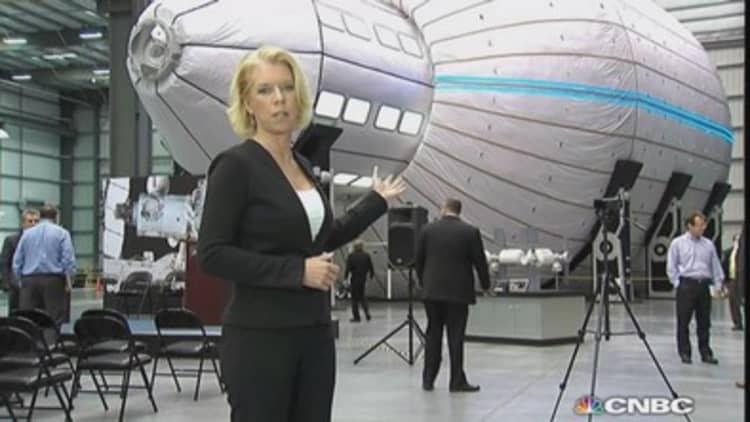
It's showtime for Robert Bigelow.
The real estate developer and hotel magnate estimates he's spent $275 million of his own fortune researching, building, and testing expandable living areas for outer space at Bigelow Aerospace, a company he founded in North Las Vegas 16 years ago.
NASA wants to see if he's right. It's paying him almost $18 million for one of his inflatable habitats to go to the International Space Station later this year.
Read MoreThe new space race (sort of): SpaceX vs Boeing
"It's the first of its kind, and it's going to be the first module to go up onto the space station since the shuttle program," said former Space Shuttle Discovery pilot George Zamka, who now works for Bigelow.
The module being sent up on a SpaceX rocket in September is called the Bigelow Expandable Activity Module, or BEAM. It will fit snugly onto the payload of a rocket and then, once deployed, Zamka said it will expand in less than five minutes to "the size of a medium travel trailer."
NASA wants to dock the BEAM to one of its ports and watch what happens. "What we'll be interested in is how it expands," said Bill Gerstenmaier, who heads up NASA's human space exploration program. "Does it expand in a longitudinal direction? Does it expand in a circumferential direction? As it expands, does it impart any loads back into the space station? We'll be looking at that to see if those things are concerns."
Bigelow has successfully tested the inflatable habitat technology with two self-funded launches, but docking with the space station will be different. "This is not a free flyer," he said. "This spacecraft is attaching to a $100 billion machine."
Once the BEAM inflates, space station astronauts will test it over two years for things like leaks, radiation levels, and acoustics. If they want to go inside, they will have to pump in air first, but BEAM may turn out to be an attractive getaway.
The "station is quite noisy," said Bigelow. Gerstenmaier added: "It may become a very popular place for crews."
Safest thing 'by far'
Another question is how durable and safe Bigelow's expandable structure will be over the long term. "The debris protection actually is sturdier than what's on the space station," said Zamka. "It's actually like a steel-belted tire, except for the material that's in there is stronger than steel."
Bigelow said tests indicate that if the BEAM's skin is penetrated by debris, the leak would grow slowly. "The crew has a tremendous amount of time to provide a patch for that," he said. "These systems are extremely reliable, the safest thing that mankind could be in today by far."
Read More Google, SpaceX to join forces: Report
BEAM is just the beginning for Bigelow. The company plans to build two larger habitats to be ready for commercial liftoffs by 2017, even though there are currently no private space taxis ready and no customers lined up.
"I think it's an acceptable risk to create that investment, which is going to be substantial, to build these two spacecraft to ship out of here by the end of '17," Bigelow said. By then, both SpaceX and Boeing may have private transportation ready.
Private property rights on the moon
Bigelow hopes to have habitats going to the moon in about a decade, providing structures for commercial mining operations or research. He's working with the Federal Aviation Administration to develop policies that will grant some sort of property rights to companies that risk lives and treasure to get to the moon.
Why the FAA? That agency issues launch licenses, and in the future, Bigelow said the FAA is planning to restrict licenses so that one American company is blocked from planning a trip to the exact spot on the moon where another U.S. venture has already set up shop. Whether other countries will respect such private commercial claims remains to be seen.
Read More SpaceX, Elon Musk and the reusable rocket dream
A lot still needs to be worked out. "The next step is probably, 'What is this boundary where you are sufficiently safe?'" Bigelow asked. "What is this standoff distance?'" He thinks a buffer zone on the moon between commercial neighbors may have to be greater than 100 miles. "I think it has to be a fair distance."
As for astronaut Zamka, it's been a change moving from NASA to a small private venture. But he's enjoying himself. "I was in the Marines, and one of the things I liked about being in the Marines is there's not that many of us, so when there's not that many of you, you get to do more things," he said.
While the private sector isn't currently giving him astronomical pay, he sees astronomical potential, and the chance to return to space, this time as a commercial astronaut. "We're doing tremendously interesting stuff," said Zamka, "and I get to be more directly involved with more parts of that."


